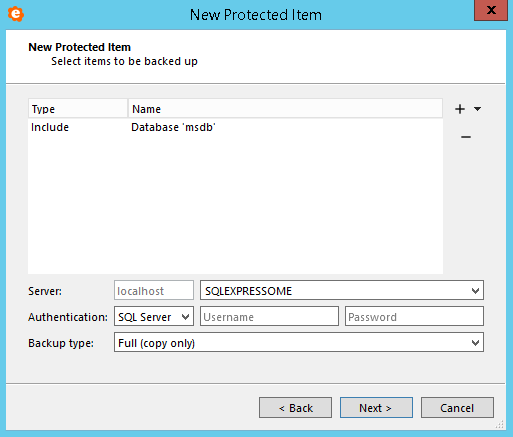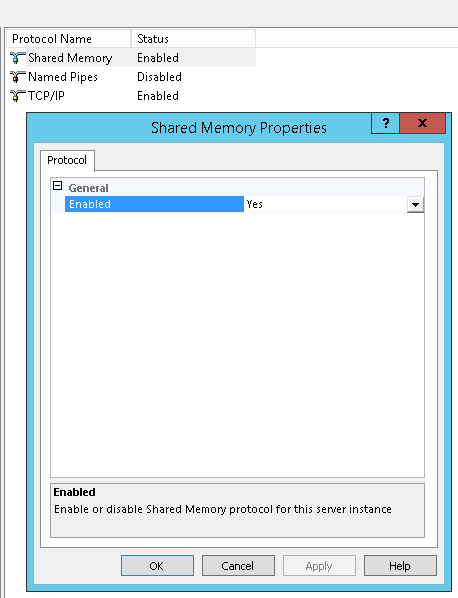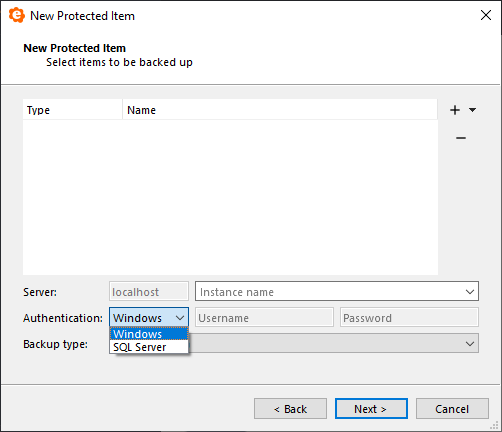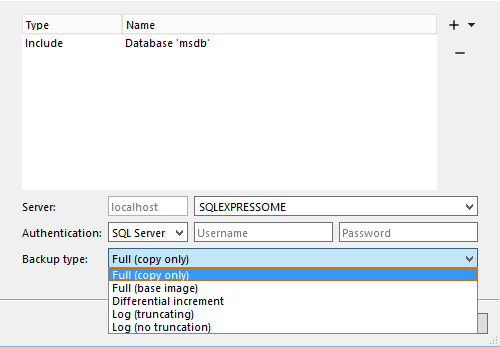Buscar en
Copia de seguridad de "Microsoft SQL Server".
Este tipo de elemento protegido realiza una copia de seguridad de una base de datos de Microsoft SQL Server. La tecnología subyacente es VDI y es compatible con SQL Server 2005 y posteriores.
No se almacenan datos en el disco local. Según el tipo de "Salida del programa", no aparece ninguna barra de progreso ni ETA durante una copia de seguridad de Microsoft SQL Server.
Las bases de datos se copian de una en una. Si necesita coherencia puntual en varias bases de datos, utilice la opción "Application-Aware Writer".
Detalles de la conexión
Al configurar el nuevo elemento protegido MSSQL, los detalles de conexión deben ser suministrados antes de seleccionar las bases de datos. eazyBackup sólo se conectará a SQL Server que se ejecute en la máquina local. Debe introducir el nombre de la instancia, o dejar el campo en blanco para utilizar la instancia por defecto.

Dirección
La dirección es siempre localhost, pero EazyBackup no utiliza direcciones TCP o puertos TCP para conectarse a las instancias de SQL Server. eazyBackup utiliza "Memoria Compartida" para conectarse a las instancias de SQL Server.
El uso de EazyBackup de la conexión de "Memoria Compartida" mejora el rendimiento de algunas operaciones, a expensas de trabajar sólo en la máquina local; pero el uso de eazyBackup de VDI requiere que se ejecute contra la máquina local de todos modos.
Si tiene problemas para conectarse a su servidor SQL Server, debe asegurarse de que el "Protocolo de memoria compartida" está activado en el Administrador de configuración de SQL Server.
Abrir el Administrador de Configuración de Sql Server -> Configuración de Red de SQL Server -> Protocolos -> Memoria Compartida -> Habilitar

Conductor
OLE DB y ODBC son métodos de acceso a datos que utilizan "controladores" / "proveedores" conectables para conectarse a bases de datos como SQL Server. Los siguientes controladores para OLE DB / ODBC son compatibles con SQL Server:
| Conductor | Soporte de TLS 1.2 | Notas |
| MSOLEDBSQL | Sí | Incluido con SQL Server 2016 y 2017; descarga opcional desde https://www.microsoft.com/en-us/download/details.aspx?id=56730 |
| SQLNCLI11 | Sí | Incluido en SQL Server 2012 y 2014; descarga opcional desde https://www.microsoft.com/en-us/download/details.aspx?id=50402 |
| SQLNCLI10 | No | Incluido en SQL Server 2008 |
| SQLNCLI | No | Incluido en SQL Server 2005 |
| SQLOLEDB | No | Incluido con SQL Server (todas las versiones); Incluido con Windows desde XP / Server 2003 |
EazyBackup se ha ido actualizando con el paso del tiempo para soportar la prueba de controladores adicionales:
| Versión de EazyBackup | Conductor preferido | Conductor(es) de reserva |
| >= 18.9.6, >= 18.8.6 | MSOLEDBSQL | SQLNCLI11, SQLOLEDB |
Puede listar los controladores instalados
- para ODBC, a través del programa odbcad32.exe > pestaña "Drivers"; o bien
- para OLE DB, a través de este fragmento de PowerShell.
Autenticación
EazyBackup le permite conectarse a SQL Server utilizando la autenticación de Windows (que se ejecuta como la cuenta de servicio de copia de seguridad - por lo general NT SERVICE\backup.delegate o SYSTEM), o la autenticación nativa de SQL Server.
- Si se utiliza la autenticación de Windows, la conexión se produce como la cuenta de servicio de copia de seguridad.
- Puede asignar esta cuenta de usuario de Windows para que tenga derechos de administrador del sistema dentro de SQL Server.
- Si utiliza la autenticación de SQL Server, debe introducir un nombre de usuario y una contraseña válidos para conectarse a SQL Server.
La suplantación no está disponible actualmente para la autenticación de Windows. Las futuras versiones de eazyBackup soportarán la suplantación para la autenticación de Windows.

Múltiples instancias
EazyBackup soporta copias de seguridad de múltiples instancias de SQL Server. Puede seleccionar una instancia para la copia de seguridad, introduciendo el nombre de la instancia en el campo "Nombre de Instancia". Deje este campo en blanco para utilizar la instancia por defecto.
EazyBackup Backup lista automáticamente las instancias disponibles para su selección en el menú desplegable.
Modo de copia de seguridad
Por defecto, EazyBackup opta por realizar una exportación completa de la base de datos desde SQL Server, y luego utiliza su propio sistema de deduplicación para optimizar los datos almacenados/cargados.
Es la opción "Completa (sólo copia)". Equivale a la sentencia T-SQL BACKUP WITH COPY_ONLY.
Debido a que EazyBackup puede deduplicar eficientemente las copias de seguridad de imágenes completas, normalmente es suficiente con tomar sólo copias de seguridad completas de SQL Server en eazyBackup.

Imágenes base
Tiene la opción de utilizar el propio sistema de copias de seguridad diferenciales/de registro de SQL Server. Esto puede ser más eficiente, pero requiere trabajo administrativo adicional y complica el proceso de restauración de datos.
El servidor SQL Server mantiene una única referencia de punto en el tiempo, a partir de la cual puede producir copias de seguridad diferenciales y/o copias de seguridad basadas en registros. Cuando se realiza una nueva copia de seguridad "Completa (imagen base)", la referencia de punto en el tiempo se desplaza hacia delante, de modo que cualquier copia de seguridad diferencial y/o basada en registros futura se basa en la última copia de seguridad de imagen base.
Para utilizar el sistema de copias de seguridad diferenciales/de registro propio de SQL Server, debe crear varios elementos protegidos (cada uno con una programación diferente) para capturar tanto una imagen base como copias de seguridad diferenciales/de registro. Al crear varios elementos protegidos, puede programar, informar y gestionar de forma individual las políticas de retención de las copias de seguridad básicas y diferenciales/de registro.
Si está utilizando EazyBackup junto con otro producto para las copias de seguridad del servidor SQL, debe asegurarse de que sólo un producto está tomando copias de seguridad de la imagen base. De lo contrario, es posible que una cadena de copias de seguridad diferenciales/de registro esté incompleta.
Diferencial
EazyBackup puede utilizar los propios sistemas de SQL Server para realizar copias de seguridad diferenciales. En este modo, puede hacer regularmente copias de seguridad "diferenciales base", y luego una serie de pequeñas copias de seguridad "diferenciales incrementales", cada una conteniendo la diferencia de la última copia de seguridad base. Estas operaciones son equivalentes a las sentencias T-SQL BACKUP y BACKUP WITH DIFFERENTIAL respectivamente. eazyBackup seguirá deduplicando múltiples copias de seguridad base que se envíen a la misma Bóveda de Almacenamiento.
Se trata de la opción "Incremento diferencial".
Registro
Puede optar por utilizar los propios sistemas de SQL Server para las copias de seguridad de los registros. En este modo, debe realizar periódicamente copias de seguridad completas (imagen base) y regularmente copias de seguridad de registro.
Puede elegir si aplicar el truncamiento del registro. Estas operaciones son equivalentes a las sentencias T-SQL BACKUP LOG y BACKUP LOG WITH NO_TRUNCATE respectivamente. eazyBackup seguirá deduplicando todos los datos que se envíen al mismo Storage Vault.
Para utilizar el sistema de registro propio de SQL Server, debe crear varios elementos protegidos (cada uno con una programación diferente) para capturar tanto las copias de seguridad completas como las de registro.
Este modo requiere que el Modelo de recuperación de la base de datos esté configurado como "Completo" o "Registro masivo" en SQL Server. Para obtener más información, consulte https://msdn.microsoft.com/en-us/library/ms189275.aspx .
Recomendaciones
En general, recomendamos utilizar la técnica de copia de seguridad "Completa" por defecto.
Los sistemas diferenciales/de registro nativos de SQL Server pueden utilizarse si experimenta problemas de rendimiento con el modo predeterminado; sin embargo, debe asegurarse de que
- Ningún otro sistema de copia de seguridad está restableciendo la última copia de seguridad base;
- Siempre que el diferencial/registro haga una copia de seguridad con éxito, que la base también ha hecho recientemente una copia de seguridad con éxito;
- Las copias de seguridad de base se realizan regularmente para minimizar la sobrecarga de los diferenciales.
- La retención se gestiona cuidadosamente para garantizar que la recuperación sea posible
Formas alternativas de hacer copias de seguridad de Microsoft SQL Server
Puede utilizar el tipo "Application-Aware Writer" para realizar copias de seguridad de SQL Server utilizando el VSS Writer. Comparado con el enfoque VDI estándar de eazyBackup, esta opción permite una información de progreso más detallada, y puede tomar una instantánea consistente en un punto en el tiempo de múltiples bases de datos a la vez; pero ofrece un control más limitado sobre las características de SQL Server como el truncado de registros. Los archivos resultantes también deben restaurarse de forma diferente.
Puede utilizar la función "Comandos" de eazyBackup para llamar a osql/sqlcmd para ejecutar una sentencia T-SQL BACKUP contra la base de datos, y luego hacer una copia de seguridad del archivo en cola resultante con el tipo "Archivos y carpetas". Esta opción requiere más espacio temporal en disco que el sistema incorporado anteriormente.
Puede utilizar el tipo "Archivos y carpetas" para realizar copias de seguridad de archivos de base de datos individuales si la opción "Tomar instantánea del sistema de archivos" está seleccionada. Sin embargo, el tipo de copia de seguridad "Archivos y carpetas" no invoca el escritor VSS de SQL Server, por lo que (en el mejor de los casos) produciría una copia de seguridad "coherente con fallos" y es no se recomienda.